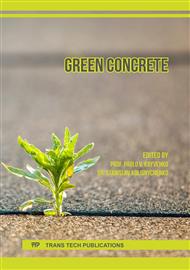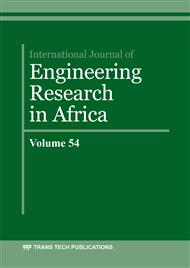[1]
T. R. Naik, Sustainability of cement and concrete industries, Proceedings of the International Conference Global Construction: Ultimate Concrete Opportunities, Dundee, Scotland, July 2005, pp.141-150.
DOI: 10.1680/asic.34044.0017
Google Scholar
[2]
Malhotra, V M, Role of Supplementary Cementing Materials and Superplasticizers in Reducing Greenhouse Gas Emissions, Proceedings of ICFRC International Conference on Fiber Composites, High-Performance Concrete, and Smart Materials, Chennai, India, January 2004, pp.489-499.
Google Scholar
[3]
Naik, T R, and Kraus, R N., The Role of Flowable Slurry in Sustainable Developments in Civil Engineering, Proceedings of the ASCE Conference on Materials and Construction - Exploring the Connection, Cincinnati, Ohio, 1999, 9 pages.
Google Scholar
[4]
Malhotra, V.M., Introduction: Sustainable Development and Concrete Technology, ACI Concrete International, 24(7) (2002) p.22.
Google Scholar
[5]
McCaffrey, R., Climate Change and the Cement Industry, Global Cement and Lime Magazine, (Environmental Special Issue), 2002, pp.15-19.
Google Scholar
[6]
Saptahari Sugiri, Herlien D. Setio, Ivindra Pane, Abdi Nassa Naitutu, Experimental Studies Of Mortar Geopolymer Based On Low Calcium Fly Ash (Type F), Proceedings of the International Conference on Sustainable Infrastructure and Built Environment in Developing Countries November, 2-3, 2009, Bandung, West Java, Indonesia.
Google Scholar
[7]
Djwantoro Hardjito, Steenie E. Wallah, Dody M.J. Sumajouw, and B.V. Rangan, Factors Influencing the Compressive Strength of Fly Ash-Based Geopolymer Concrete, Civil Engineering Dimension, Vol. 6, No. 2, 88–93, September 2004, ISSN 1410-9530.
DOI: 10.1080/13287982.2005.11464946
Google Scholar
[8]
Tarek Salloum, Effect of Fly ash Replacement on Alkali and Sulphate Resistance of Mortars, MS Thesis, Department of Building, Civil and Environmental Engineering, Concordia University Montreal, Quebec, Canada, July (2007).
Google Scholar
[9]
Daniel L.Y. Kong, Jay G. Sanjayan, Damage behavior of geopolymer composites exposed to elevated temperatures, Cement & Concrete Composites 30 (2008):986-991.
DOI: 10.1016/j.cemconcomp.2008.08.001
Google Scholar
[10]
B. V. Rangan, Fly Ash-Based Geopolymer Concrete, Research Report GC 4, Faculty of Engineering, Curtin University of Technology, Perth, Australia, (2008).
Google Scholar
[11]
Mehta, P K., Greening of the Concrete Industry for Sustainable Development, ACI Concrete International, Vol. 24, No. 7, 2002, pp.23-28.
Google Scholar
[12]
Demirel B., The effect of the using waste marble dust as fine sand on the mechanical properties of the concrete,, International Journal of the Physical Sciences, V.5, Issue 9, pp.1372-1380, (2010).
Google Scholar
[13]
Binici H., kaplan H., and yilmaz S., Influence of marble and limestone dust as additives on some mechanical properties of concrete,, Scientific Research and Essay, V. 29, pp.372-379, (2007).
Google Scholar
[14]
Alshahwany R.B.A., Effect of Partial Replacement of Sand with Limestone Filler on Some Properties of Concrete,, Al- Rafidain Engineering, V. 19, Issue 3, pp.37-48, (2011).
DOI: 10.33899/rengj.2011.27014
Google Scholar
[15]
Hebhoub H., Aoun H., Belachia M., and Houari H., Use of Waste Marble Aggregate in Concrete,, Elsevier Journal of Construction and Building Materials, V. 25, Issue 3, pp.1167-1171, (2011).
DOI: 10.1016/j.conbuildmat.2010.09.037
Google Scholar
[16]
Rai B., Khan N.H., Kumar A., and Tabin R.S., Influence of Marble Powder/granules in Concrete Mix,, IJCSE, V. 1, No. 4, pp.827-834, (2011).
Google Scholar
[17]
Ali E. (2011), Effects of the usage of diatomite and waste marble powder as partial replacement of cement on the mechanical properties of concrete,, Construction and Building Materials, V.25, issue 2, pp.806-812, (2011).
DOI: 10.1016/j.conbuildmat.2010.07.002
Google Scholar
[18]
Corinaldesi V., Moriconi G., Naik T.R., Characteristics of marble powder for its use in mortar and concrete,, NMET/ACI International Symposium on sustainable development of cement and concrete, 2005, Toronto, Canada.
Google Scholar
[19]
V. Ramasamy (2011). Compressive Strength and Durability Properties of Rice Husk Ash Concrete. KSCE Journal of Civil Engineering (2012) vol 16(1): pp.93-102.
DOI: 10.1007/s12205-012-0779-2
Google Scholar
[20]
N.Nadia Amira, M H Wan Ibrahim,*, A.H Abdul Ghani, A Z Mohd Ali, and M F Arshad (2017). Compressive Strength of Construction Materials Containing Agricultural Crop Wastes: A Review. ISCEE (2016).
DOI: 10.1051/matecconf/201710301018
Google Scholar
[21]
R. Kumar, M. Yaseen, N. Shafiq, and A. Jalal, Influence of Metakaolin, Fly Ash and Nano Silica on Mechanical and Durability Properties of Concrete,, in Key Engineering Materials, 2017, pp.8-14.
DOI: 10.4028/www.scientific.net/kem.744.8
Google Scholar
[22]
Mo, K.H., Alengaram, U.J., Jumaat, M.Z., Yap, S.P. and Lee, S.C., 2016. Green concrete partially comprised of farming waste residues: a review. Journal of Cleaner Production, 117, pp.122-138.
DOI: 10.1016/j.jclepro.2016.01.022
Google Scholar
[23]
USDA - National Agricultural Statistics Service - Charts and Maps - Corn: Production by Year, US, (n.d.). https://www.nass.usda.gov/Charts_and_Maps/Field_Crops/cornprod.php (accessed March 19, 2020).
Google Scholar
[24]
BS EN 12350-2. Testing fresh concrete, Part 2: Slump-test. BSI; (2009).
Google Scholar
[25]
BS EN 12390-3. Testing harden concrete. Compressive strength of test specimens. BSI; (2009).
Google Scholar
[26]
BS EN 12390-6. Testing hardened concrete. Tensile splitting strength of test specimens. BSI; (2009).
DOI: 10.3403/30200045
Google Scholar
[27]
BS EN 12390-5. Testing hardened concrete. Flexural strength of test specimens. BSI; (2009).
Google Scholar
[28]
BS EN 12390-13. Testing hardened concrete. Determination of secant modulus of elasticity in compression. BSI; (2013).
DOI: 10.3403/30397532
Google Scholar
[29]
British Standards Institution, BS EN 12390-7:2000 Part 7: Density of hardened concrete, 389 (2000).
Google Scholar
[30]
BS ISO 1920-8, 2009. Determination of drying shrinkage of concrete for samples prepared in the field or in the laboratory.
Google Scholar
[31]
Bheel, N., Jokhio, M.A., Abbasi, J.A., Lashari, H.B., Qureshi, M.I. and Qureshi, A.S., 2020. Rice husk ash and fly ash effects on the mechanical properties of concrete. Engineering, Technology & Applied Science Research, 10(2), pp.5402-5405.
DOI: 10.48084/etasr.3363
Google Scholar
[32]
Bheel, N. and Adesina, A., 2020. Influence of Binary Blend of Corn Cob Ash and Glass Powder as Partial Replacement of Cement in Concrete. Silicon, pp.1-8.
DOI: 10.1007/s12633-020-00557-4
Google Scholar
[33]
Bheel, N., Memon, A.S., Khaskheli, I.A., Talpur, N.M., Talpur, S.M. and Khanzada, M.A., 2020. Effect of Sugarcane Bagasse Ash and Lime Stone Fines on the Mechanical Properties of Concrete. Eng. Technol. Appl. Sci. Res, 10(2), pp.5534-5537.
DOI: 10.48084/etasr.3434
Google Scholar
[34]
I. Türkmen, S.B. Findik, Several properties of mineral admixtured lightweight mortars at elevated temperatures, Fire Mater. (2013). https://doi.org/10.1002/fam.1030.
DOI: 10.1002/fam.1030
Google Scholar
[35]
K.H. Mo, F.A. Mohd Anor, U.J. Alengaram, M.Z. Jumaat, K.J. Rao, Properties of metakaolin-blended oil palm shell lightweight concrete, Eur. J. Environ. Civ. Eng. (2018). https://doi.org/10.1080/19648189.2016.1229222.
DOI: 10.1080/19648189.2016.1229222
Google Scholar
[36]
Foong, K. Y., Alengaram, U. J., Jumaat, M. Z. and Mo, K. H. (2015). Enhancement of the mechanical properties of lightweight oil palm shell concrete using rice husk ash and manufactured sand. Journal of Zhejiang University-SCIENCE A (Applied Physics & Engineering, 16(1), 59 – 69.
DOI: 10.1631/jzus.a1400175
Google Scholar
[37]
CCA (2002). Drying Shrinkage of Cement and Concrete. Cement, Concrete and Aggregates, Australia Data Sheet, 2 – 6.
Google Scholar
[38]
Chatveera, B. and Lertwattanaruk, P. (2011). Durability of Conventional Concretes Containing Black Rice Husk Ash. Journal of Environmental Management, 92(1),59-66.
DOI: 10.1016/j.jenvman.2010.08.007
Google Scholar
[39]
Habeeb G. A., Fayyadh M. M. (2009). Rice husk ash concrete: the effect of RHA average particle size on mechanical properties and drying shrinkage. Australian Journal of Basic and Applied Sciences, 3(3), 1616 - 1622.
Google Scholar
[40]
Khassaf, S. I., Jasim, A. T. and Mahdi, F. K. (2014). Investigation the Properties of ConcreteContaining Rice Husk Ash to Reduction the Seepage in Canals. International Journal of Scientific & Technology Research, 3(4), 348 – 354.
Google Scholar
[41]
Mahmud, H. B., Malik, M. F. A., Kahar, R. A., Zain, M. F. M. and Raman, S. N. (2009). Mechanical properties and Durability of Normal and Water Reduced High Strength 60 grade concrete Containing Rice Husk Ash. Journal of Advanced Concrete Technology, 7(1), 21-30.
DOI: 10.3151/jact.7.21
Google Scholar
[42]
Wu, D.S. and Peng, Y. N. (2003). The macro and micro properties of cement pastes with silica rich materials cured by wet mixed steaming injection. Cement and Concrete Research, 33, 1331-1345.
DOI: 10.1016/s0008-8846(03)00059-0
Google Scholar



